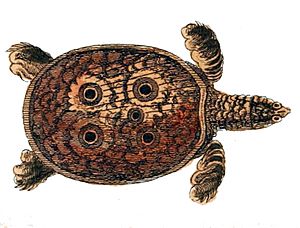Indian softshell turtle facts for kids
Quick facts for kids Indian softshell turtle |
|
|---|---|
 |
|
| The shell of a young turtle. In an adult the dark spots are hard to see, or are no longer there | |
| Conservation status | |
| Scientific classification | |
| Kingdom: | |
| Class: | |
| Order: | |
| Suborder: | |
| Family: | |
| Genus: |
Nilssonia
|
| Binomial name | |
| Nilssonia gangetica (Cuvier, 1825)
|
|
The Indian softshell turtle (Nilssonia gangetica), also known as the Ganges softshell turtle, is a special kind of softshell turtle. It lives in big rivers like the Ganges and Mahanadi in India and Bangladesh. These turtles can grow quite large, with their shells reaching up to 94 cm (37 in) long!
This turtle has a long neck and a long nose. This helps it easily poke just the tip of its nose out of the water to breathe while staying mostly hidden. Its shell is oval-shaped, flat, and smooth, which helps it swim very fast in the water.
Contents
What Do Indian Softshell Turtles Eat?
Indian softshell turtles are mostly meat-eaters. They love to munch on fish and amphibians like frogs. They also eat carrion, which is the remains of dead animals. Sometimes, they will also eat aquatic plants.
Where Do These Turtles Live?
These turtles are found in the large river systems of India and Bangladesh. They prefer slow-moving parts of rivers and canals. In some places, like the temple ponds of Odisha, people consider them sacred and protect them.
Why Are Indian Softshell Turtles Important?
The Indian softshell turtle is an important part of its river ecosystem. It helps keep the rivers clean by eating dead animals. Sadly, this turtle is currently listed as a vulnerable species. This means it is at risk of becoming endangered if we don't protect it.
What Threats Do Indian Softshell Turtles Face?
The Indian softshell turtle faces several dangers that threaten its survival:
- Illegal Hunting: These turtles are often hunted illegally. Their meat is sometimes sold in markets, and their shells are used to make items like masks for tourists.
- Habitat Loss: The places where these turtles live are changing. New dams are built, and drainage works change the rivers.
- Human Activities: More fishing and farming activities near the rivers also affect the turtles' homes and food sources.
Protecting these amazing creatures means protecting their river homes and stopping illegal hunting.
Images for kids



